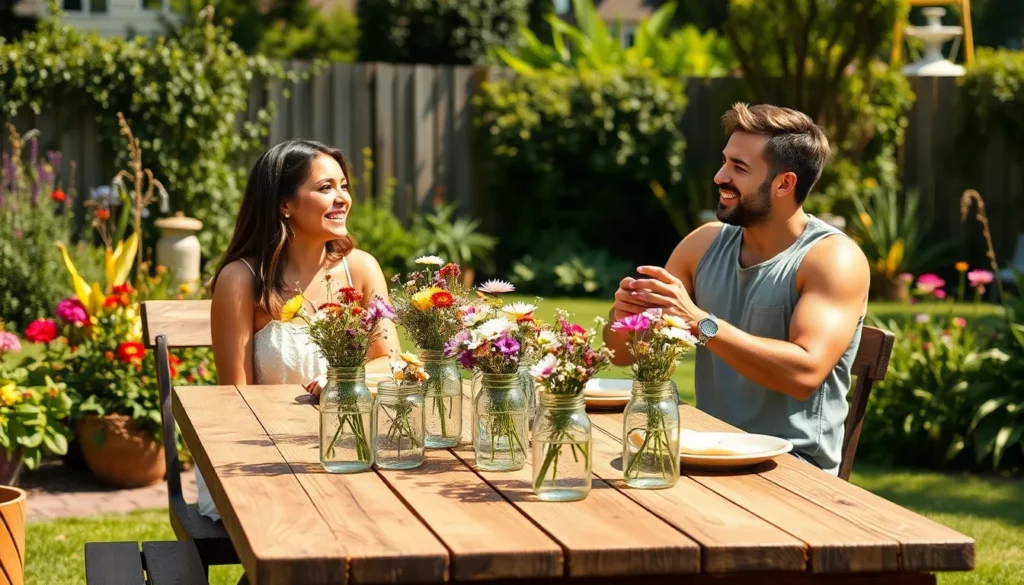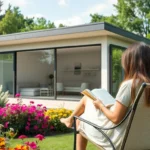We’ve all experienced that magical moment when our outdoor space transforms from ordinary to extraordinary – and often it’s the perfect garden table that makes all the difference. Whether you’re dreaming of intimate morning coffees surrounded by blooming flowers or hosting memorable dinner parties under the stars your choice of garden table sets the entire mood for your outdoor sanctuary.
The right garden table doesn’t just serve as furniture – it becomes the heart of your outdoor living experience. From rustic wooden farmhouse styles that blend seamlessly with natural surroundings to sleek modern designs that make bold statements we’ve discovered countless ways to elevate your garden’s aesthetic appeal.
Today’s garden table options offer incredible versatility in materials sizes and styles. You’ll find everything from space-saving bistro sets perfect for cozy balconies to expansive dining tables that accommodate large gatherings. We’re excited to share our favorite garden table ideas that’ll transform your outdoor space into the perfect entertaining and relaxation destination.
Choose the Perfect Size Garden Table for Your Space
Selecting the right dimensions for your garden table sets the foundation for comfortable outdoor dining and entertaining. We’ll guide you through the essential measurements and considerations to ensure your perfect fit.
Measure Your Available Outdoor Area
Start by measuring your patio, deck, or garden space to determine the maximum table dimensions you can accommodate. Use a measuring tape to record the length and width of your designated dining area, then subtract at least 6 feet from each dimension to allow proper circulation space.
Create a visual layout by marking the potential table placement with chalk or rope before making your purchase. This technique helps you visualize how the table will fit within your existing outdoor furniture arrangements and landscaping features.
Consider irregular spaces like L-shaped patios or areas with built-in planters, fire pits, or pergola posts. Document any obstacles or fixed features that might limit your table placement options or require custom sizing answers.
Consider Seating Requirements for Your Family
Determine your typical guest count by evaluating how many people regularly use your outdoor space for meals and gatherings. Standard garden tables accommodate 4-8 people, with rectangular tables offering more flexibility for varying group sizes.
Plan for 24 inches of table width per person to ensure comfortable elbow room and place setting space. Round tables work best for intimate conversations among 4-6 people, while rectangular tables excel at hosting larger dinner parties or family barbecues.
Factor in occasional entertaining needs by considering expandable table options or companion pieces like garden benches that can accommodate extra guests during special occasions or holiday gatherings.
Account for Walkway and Chair Space
Allow 36 inches of clearance around all sides of your garden table for comfortable chair movement and guest circulation. This spacing ensures people can easily pull out chairs, walk behind seated guests, and access serving areas without feeling cramped.
Reserve 24 inches minimum between your table edge and any walls, planters, or outdoor kitchen elements to prevent bottlenecks during active dining periods. Additional clearance becomes essential near high-traffic areas like patio doors or grilling stations.
Consider chair styles and dimensions when calculating space requirements, as bulky outdoor chairs or benches need more room than streamlined dining chairs. Swivel chairs and chairs with arms require extra clearance for comfortable use and movement.
Select Durable Materials That Withstand Weather
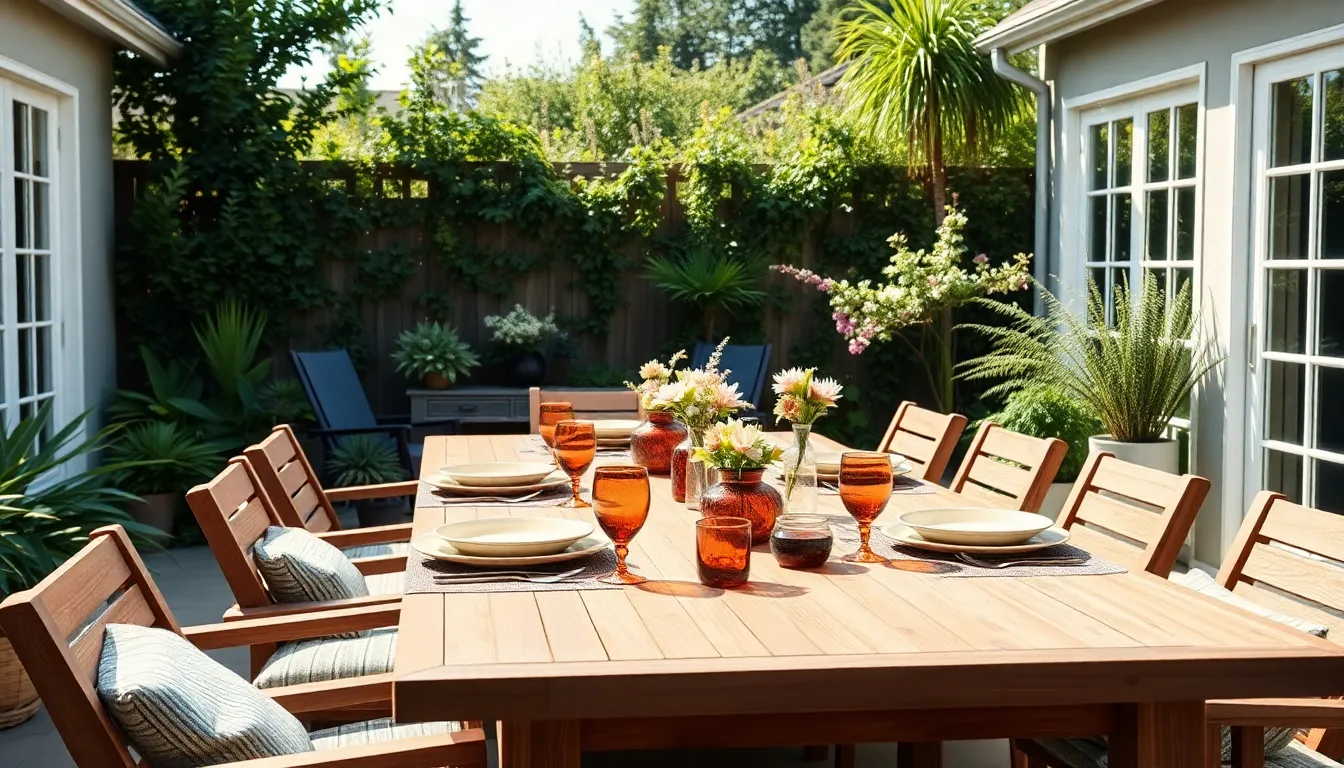
Choosing the right material for your garden table ensures years of outdoor enjoyment with minimal upkeep. Weather-resistant materials protect your investment while maintaining their aesthetic appeal through seasonal changes.
Explore Teak Wood for Natural Beauty
Teak wood stands out as our top choice for garden tables seeking both elegance and exceptional durability. This premium hardwood contains natural oils that make it highly resistant to moisture, rot, and insect damage, allowing teak tables to last for decades with minimal care. Over time, untreated teak develops a distinctive silvery-gray patina that many homeowners find appealing, though periodic oiling can preserve its original rich, warm tones.
We particularly appreciate how teak’s natural weather resistance eliminates the need for constant maintenance while providing the warmth and character that only genuine wood can offer. Investment in a quality teak garden table pays dividends through its longevity and timeless appeal that complements any outdoor design style.
Consider Aluminum for Lightweight Durability
Aluminum garden tables deliver the perfect combination of strength and portability for versatile outdoor dining. Cast and wrought aluminum options can support considerable weight while remaining easy to move when rearranging your outdoor space. This rust-resistant material thrives in areas with frequent rain or high humidity, making it ideal for coastal locations or regions with unpredictable weather patterns.
We recommend securing lightweight aluminum furniture in windy areas to prevent movement during storms. The material’s resistance to corrosion means your table will maintain its appearance without the rust concerns associated with other metals, providing reliable performance year after year.
Evaluate Composite Materials for Low Maintenance
Composite materials offer engineered answers for homeowners seeking maximum convenience with minimal upkeep. Resin wicker mimics the appearance of natural wicker while providing superior resistance to sun exposure, moisture, and temperature fluctuations that would damage traditional materials. High-density polyethylene (HDPE) lumber resists fading, cracking, and staining, making it an excellent choice for busy households wanting beautiful outdoor furniture without constant maintenance demands.
We find composite garden tables particularly valuable for families with children or frequent entertainers who need durable surfaces that can handle spills and weather exposure. These materials maintain their appearance with simple cleaning, allowing you to focus on enjoying your outdoor space rather than maintaining it.
Design a Rustic Farmhouse Garden Table Setting
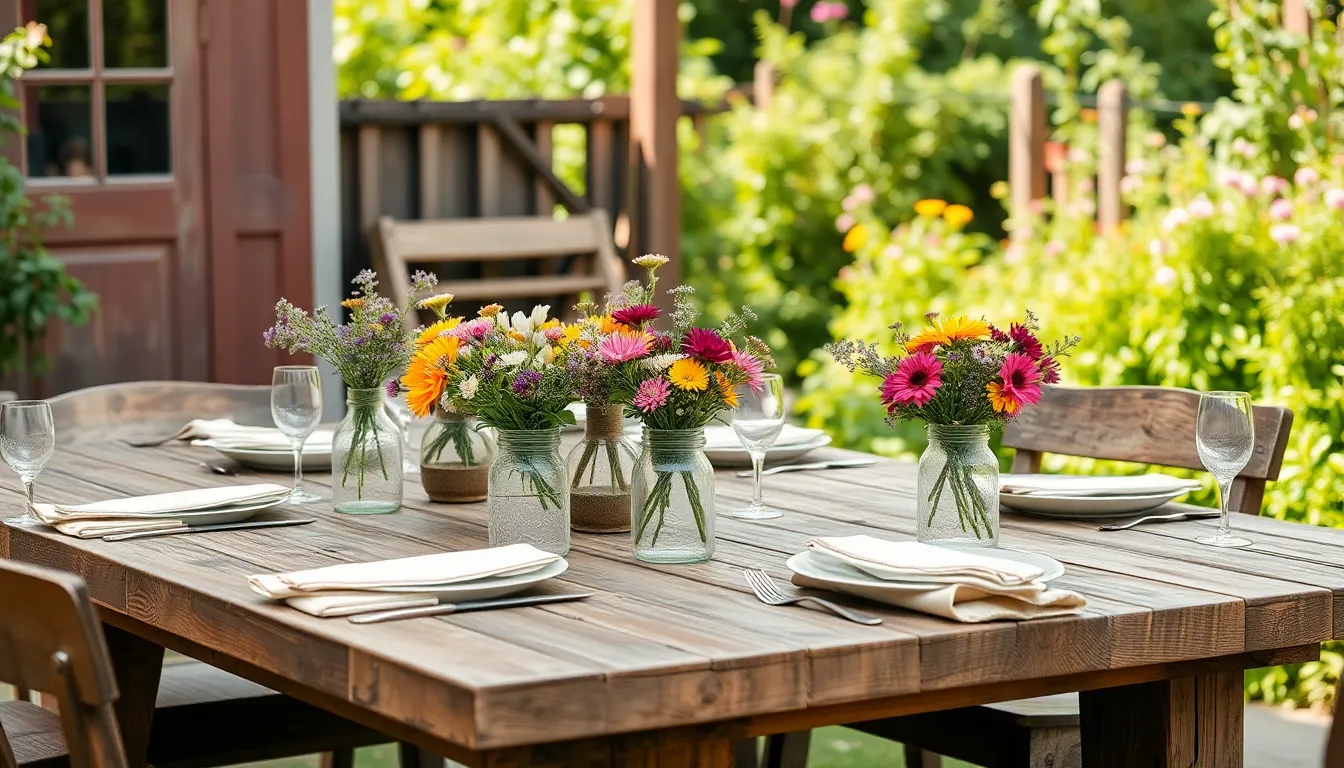
Creating an authentic rustic farmhouse garden table setting brings timeless charm to your outdoor dining space. We’ll explore three essential elements that transform any ordinary table into a welcoming centerpiece that captures the essence of countryside living.
Incorporate Weathered Wood Elements
Weathered wood serves as the foundation of any authentic farmhouse aesthetic. We recommend using reclaimed or naturally aged wood for your table construction to achieve that coveted rustic appearance. The natural patina and character marks tell a story while providing the perfect backdrop for outdoor gatherings.
Building your table with weathered wood planks creates an instant conversation starter. Choose materials like barn wood or driftwood that showcase natural weathering patterns and unique grain structures. These elements add depth and texture that new wood simply can’t replicate.
Complement your table with matching weathered wood benches or chairs. This creates a cohesive look throughout your dining area while maintaining that authentic farmhouse feel. Mix different wood tones to add visual interest without losing the rustic charm you’re working to achieve.
Add Vintage Metal Accents
Vintage metal elements introduce industrial charm that perfectly balances weathered wood textures. We suggest incorporating aged metal legs or supports beneath your table surface to create that sought after farmhouse industrial blend. Look for pieces with natural rust patina or distressed finishes that complement your wood selection.
Decorative metal accents around your table setting enhance the overall rustic atmosphere. Position vintage metal lanterns as ambient lighting options or use aged metal pitchers as unique serving pieces. These functional decorations serve dual purposes while reinforcing your design theme.
Strategic placement of metal elements creates visual anchors throughout your space. Consider adding metal plant holders or vintage buckets filled with seasonal flowers to extend the farmhouse aesthetic beyond just your table itself.
Style with Mason Jar Centerpieces
Mason jar centerpieces embody the quintessential farmhouse dining experience. We love filling these classic containers with wildflowers or fresh greenery to create simple yet elegant focal points. The clear glass showcases natural beauty while maintaining that down to earth farmhouse appeal.
Layer vintage items around your mason jar displays for added rustic character. Include weathered books, antique bottle caps, or small collectibles that reflect rural living traditions. These personal touches make your table setting unique and tell your own farmhouse story.
Seasonal updates to your mason jar arrangements keep your table setting fresh year round. Switch between spring wildflowers, summer herbs, autumn branches, or winter evergreens to maintain visual interest while staying true to your rustic theme.
Create a Modern Minimalist Outdoor Dining Area
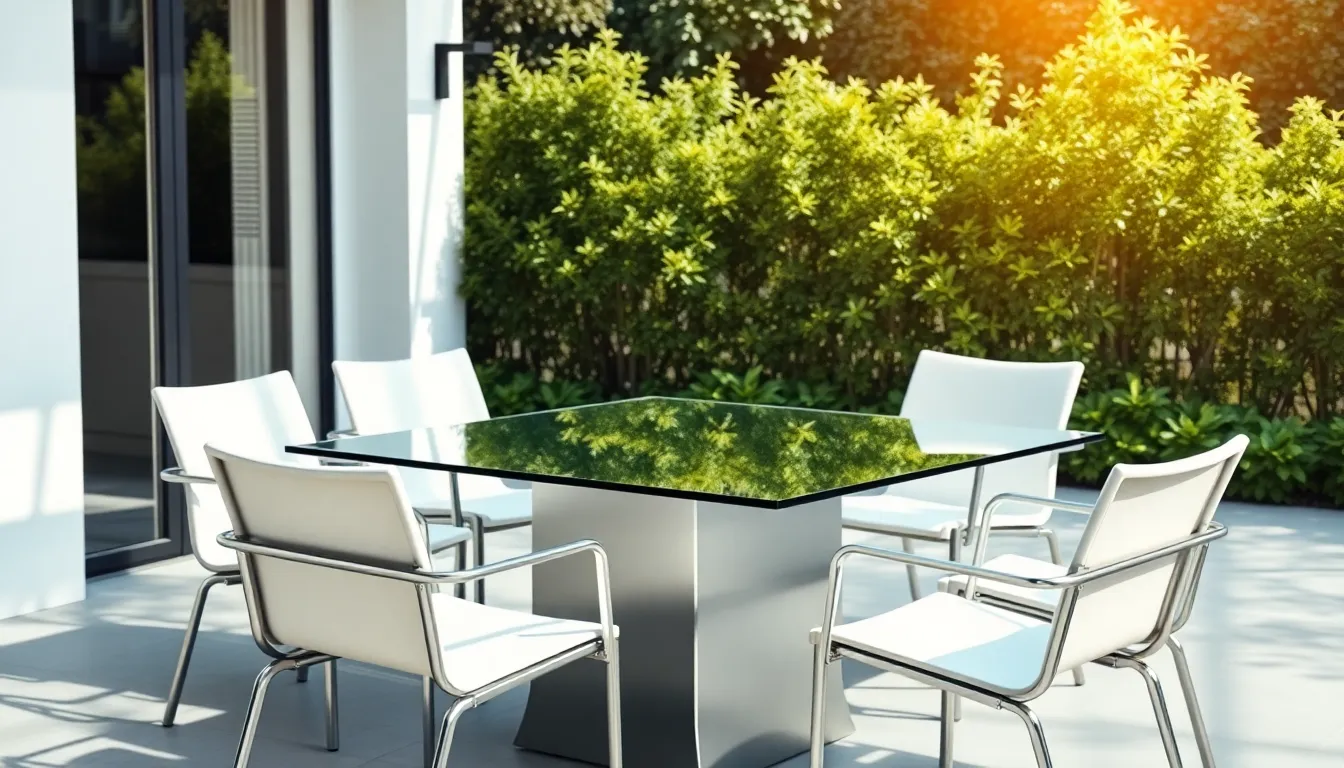
Shifting from rustic charm to contemporary sophistication transforms your outdoor space into a sleek retreat. Modern minimalist design principles create an uncluttered environment that celebrates simplicity and functionality.
Choose Clean Lines and Geometric Shapes
Square and rectangular garden tables serve as the foundation of minimalist outdoor dining areas. Geometric shapes emphasize symmetry and create visual balance that complements contemporary architecture. Angular furniture pieces eliminate unnecessary decorative elements while maintaining structural integrity.
Streamlined silhouettes define the modern aesthetic better than ornate designs. Tables with straight edges and minimal ornamentation allow the beauty of materials and proportions to take center stage. Clean profiles create a sense of spaciousness even in compact outdoor areas.
Furniture arrangements should follow grid patterns or linear configurations. Positioning chairs in precise alignment with table edges reinforces the geometric theme. Symmetrical placement of accessories and lighting fixtures enhances the overall minimalist composition.
Opt for Monochromatic Color Schemes
Limited color palettes create cohesive and uncluttered visual experiences in outdoor dining spaces. Shades of gray, white, and natural wood tones work together to establish a calming atmosphere. Monochromatic schemes prevent visual chaos and allow the garden’s natural beauty to complement the furniture.
Neutral tones provide timeless appeal that won’t conflict with seasonal plantings or changing outdoor décor. White and light gray tables reflect sunlight effectively while maintaining a fresh appearance throughout different weather conditions. Natural wood finishes add warmth without disrupting the minimalist color story.
Coordinated accessories should echo the main color scheme to maintain design consistency. Table linens, cushions, and serving pieces in matching or complementary neutral shades reinforce the sophisticated aesthetic. Seasonal updates can introduce subtle color variations without compromising the overall minimalist approach.
Select Sleek Materials Like Glass or Steel
Glass tables provide transparency that creates visual lightness in outdoor dining areas. Tempered glass surfaces offer durability while maintaining the sleek appearance essential to modern minimalist design. Glass materials reflect surrounding greenery and sky, integrating the table naturally into the garden environment.
Steel frames deliver industrial sophistication with exceptional weather resistance. Stainless steel and powder coated aluminum options provide clean lines that complement contemporary architecture. Metal construction ensures longevity while requiring minimal maintenance compared to traditional materials.
Solid wood alternatives like teak or bamboo offer natural textures within the minimalist framework. Wooden surfaces provide warmth and organic appeal while maintaining the clean aesthetic through simple finishing techniques. Industrial combinations of steel frames with reclaimed wood tops balance toughness and warmth effectively, as demonstrated by modern outdoor furniture collections from brands like IKEA and Weltevree.
Build a DIY Garden Table on a Budget
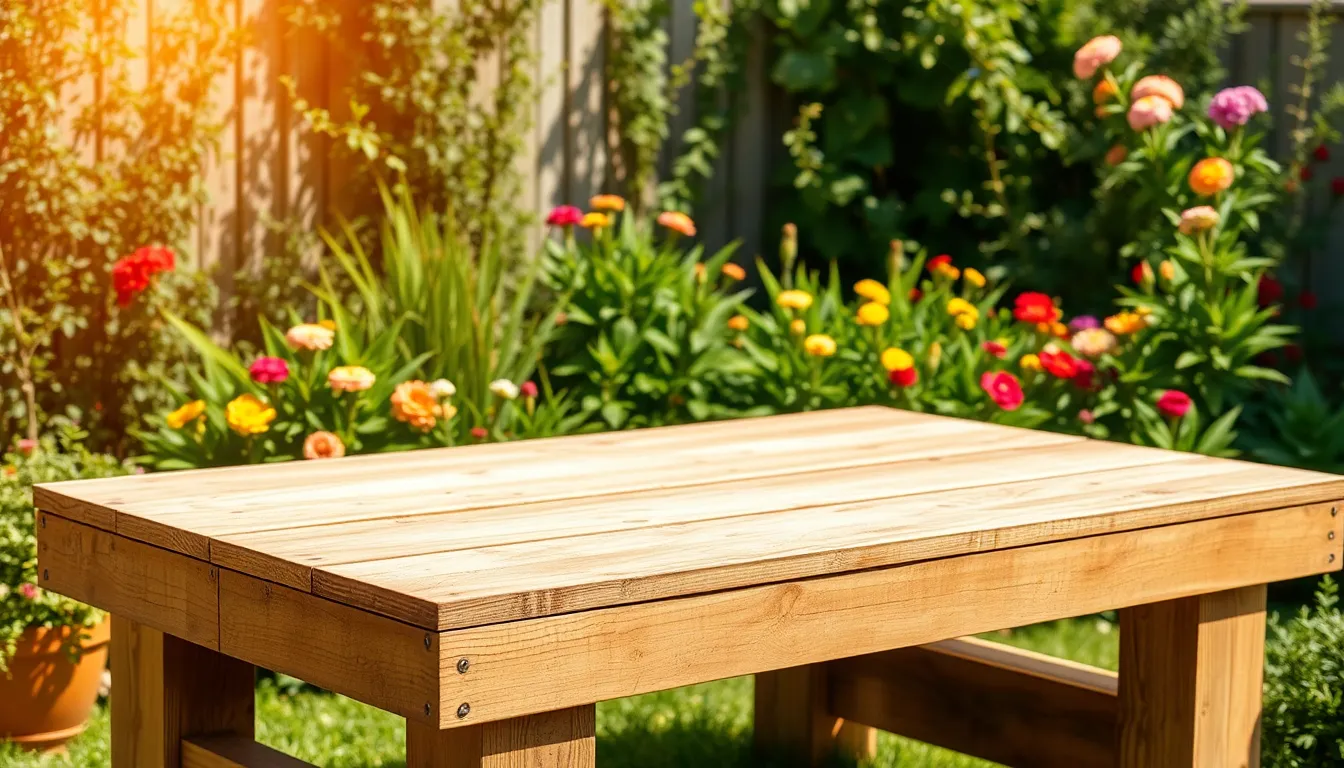
Creating your own garden table doesn’t require very costly or advanced carpentry skills. We’ve discovered several budget-friendly approaches that transform readily available materials into stunning outdoor furniture pieces.
Repurpose Old Wooden Pallets
Sourcing wooden pallets from local hardware stores or online marketplaces provides an incredibly affordable foundation for your garden table project. These versatile materials cost significantly less than traditional lumber while offering authentic rustic character.
Disassembling pallets requires only basic tools like a hammer and pry bar to separate individual boards. We recommend selecting pallets with thicker slats for better durability and stability in your final design.
Creating the tabletop involves arranging pallet boards side by side and securing them with wood screws or construction adhesive. Adding a glass top elevates the finished appearance while protecting the wood from weather damage.
Building the frame uses remaining pallet wood to construct sturdy legs and support braces. This approach typically costs under $50 for materials while producing a table that rivals expensive commercial options.
Transform Tree Stumps into Natural Tables
Utilizing tree stumps as table bases creates unique garden furniture that seamlessly blends with natural landscaping. Local tree services often provide stumps for free, making this an extremely budget-conscious option.
Preparing the stump involves sanding rough surfaces to eliminate splinters and create a smooth foundation. We suggest using progressively finer grits starting with 80-grit sandpaper and finishing with 220-grit for optimal results.
Adding the tabletop requires either a circular glass piece or wooden rounds cut to size. Glass tops offer weather resistance and easy cleaning, while wooden surfaces provide warmth and natural texture.
Sealing the wood with outdoor polyurethane or marine varnish protects against moisture and extends the table’s lifespan. This preservation step ensures your natural garden table withstands seasons of outdoor use.
Upcycle Indoor Furniture for Outdoor Use
Repurposing existing furniture transforms outdated indoor pieces into functional garden tables at minimal cost. Old dining tables, coffee tables, and side tables all present excellent candidates for outdoor conversion.
Applying weatherproof coatings protects wooden surfaces from rain, UV rays, and temperature fluctuations. Marine-grade polyurethane or exterior paint creates durable barriers that extend furniture life significantly.
Replacing hardware with stainless steel or galvanized options prevents rust and corrosion in outdoor environments. We recommend upgrading screws, bolts, and hinges to materials specifically designed for exterior use.
Reinforcing joints addresses potential weaknesses in older furniture construction. Adding corner braces or L-brackets strengthens connections that may loosen under outdoor temperature changes and humidity variations.
Incorporate Multi-Functional Garden Table Features
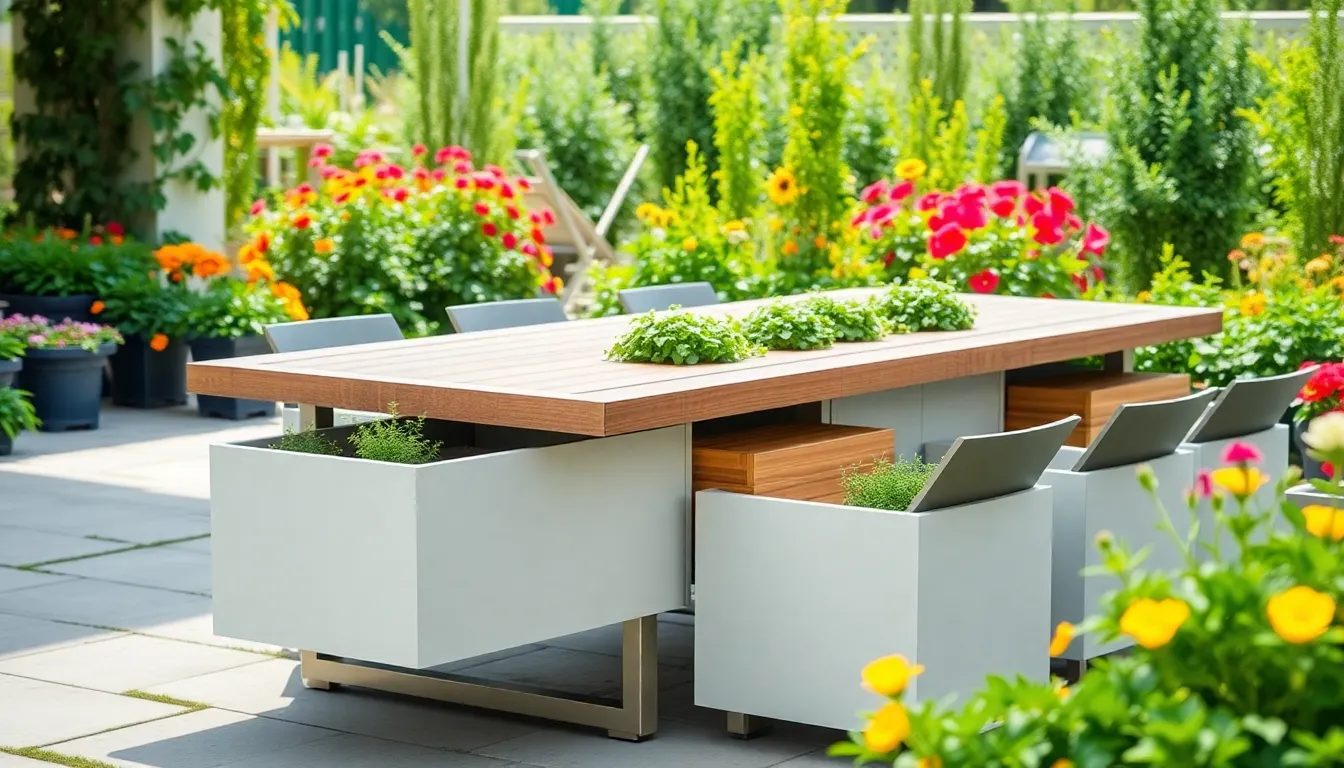
Modern garden tables offer exciting opportunities to maximize outdoor space functionality. We’ve discovered that incorporating smart design elements transforms ordinary dining surfaces into versatile outdoor workstations.
Add Built-in Storage Compartments
Storage compartments transform garden tables into organized outdoor command centers that keep essential items within reach. We recommend designing tables with hidden storage areas beneath the tabletop or along the table’s perimeter to store gardening tools, outdoor cushions, and dining accessories. Built-in drawers work exceptionally well for protecting smaller items like candles, napkins, and utensils from weather exposure.
Table designs with lift-up tops create generous storage space for bulkier items such as outdoor games, extra cushions, or seasonal decorations. We’ve found that weatherproof storage compartments with tight-fitting lids prevent moisture damage while maintaining easy access to frequently used items. These integrated answers eliminate the need for separate storage furniture, keeping gardens tidy and organized while maximizing available space.
Include Integrated Planters or Herb Gardens
Planters built directly into garden table designs create living centerpieces that enhance both functionality and visual appeal. We suggest incorporating small planters along table edges or designing removable planter inserts that fit seamlessly into the table’s center. These integrated herb gardens provide fresh ingredients for outdoor cooking while adding natural fragrance and color to dining experiences.
Centerpiece planters work particularly well for growing compact herbs like basil, rosemary, and thyme that guests can enjoy during meals. We recommend using drainage systems within integrated planters to prevent water damage to the table structure. Modular planter designs allow seasonal changes, letting you switch between herbs, succulents, or flowering plants throughout the year to maintain visual interest.
Design Extendable Surfaces for Flexibility
Extendable garden tables adapt to varying group sizes and entertainment needs throughout the outdoor season. We’ve observed that tables like the Transformer Outdoor Table can expand significantly to accommodate additional guests, making them ideal answers for both intimate dinners and larger gatherings. These adaptive designs typically feature fold-out leaves or sliding extension mechanisms that operate smoothly in outdoor conditions.
Extension mechanisms should use weather-resistant hardware to ensure reliable operation over multiple seasons. We recommend choosing extendable tables that maintain structural stability when fully expanded, preventing wobbling during use. Compact storage positions allow these versatile tables to fit smaller spaces when not entertaining large groups, maximizing outdoor area efficiency throughout the year.
Style Your Garden Table for Different Seasons
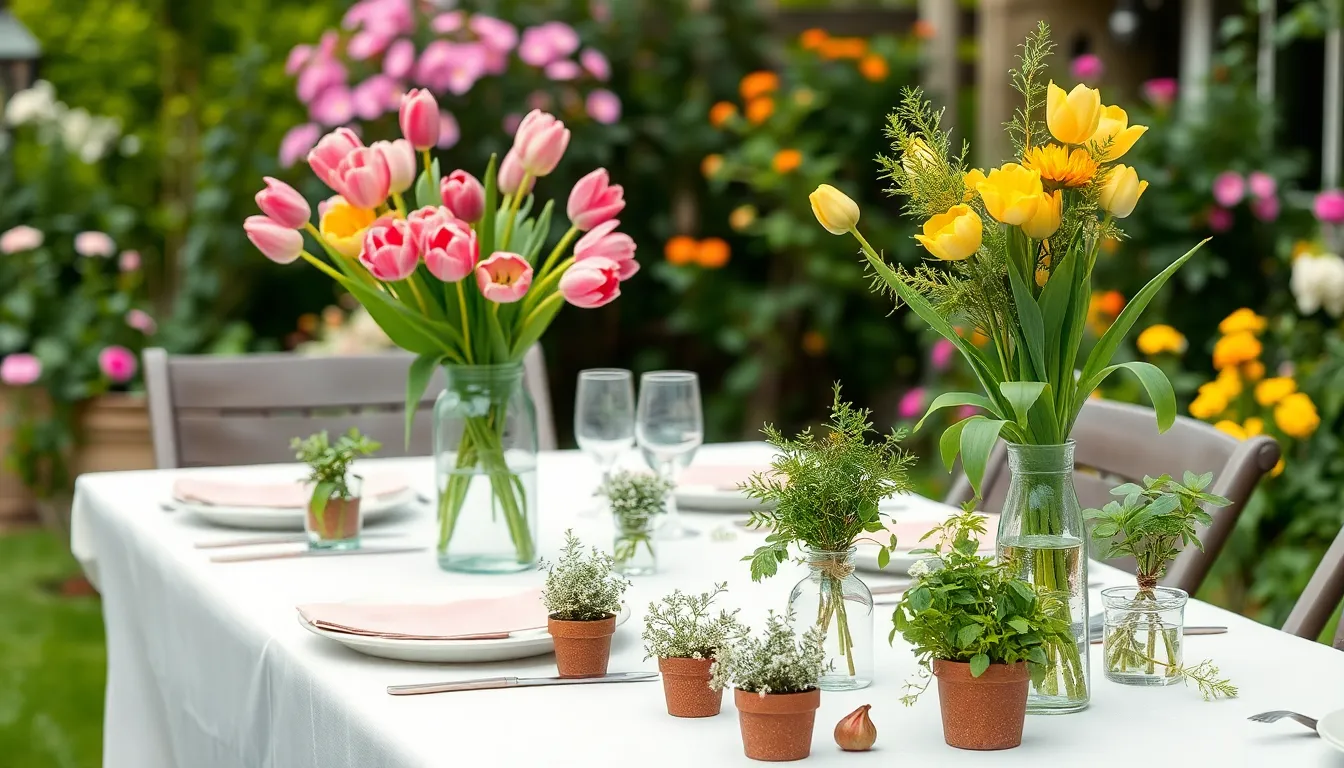
Creating a garden table display that evolves with nature’s rhythm keeps your outdoor space feeling fresh and intentional. We’ll show you how seasonal styling transforms your dining area into a celebration of each time of year.
Spring Arrangements with Fresh Flowers
Spring garden tables come alive with the season’s first blooms and tender greenery. Hand-picked roses serve as stunning centerpieces that capture the essence of renewal and growth. Seasonal flowers like tulips, daffodils, and cherry blossoms create vibrant focal points that celebrate nature’s awakening.
Greenery accents bring natural fragrance and texture to your spring tablescape. Fresh herbs like mint, rosemary, and thyme offer both aromatic appeal and culinary functionality. Delicate ferns and moss create layered textures that complement flowering arrangements perfectly.
Mixing different flower heights and textures creates visual interest throughout your spring display. Small potted plants scattered along the table’s length extend the garden feeling beyond a single centerpiece. Clear glass vases allow the natural beauty of stems and water to enhance the overall fresh aesthetic.
Summer Setups with Bright Colors
Summer garden tables thrive with bold, vibrant colors that reflect the season’s energy and warmth. Bright dahlias in shades of coral, magenta, and golden yellow create eye-catching centerpieces that withstand heat beautifully. Colorful zinnias and marigolds add cheerful bursts that complement summer’s abundant sunshine.
Candles provide essential ambiance for long summer evenings and outdoor entertaining. Citronella candles offer practical mosquito protection while maintaining atmospheric lighting. Lanterns and string lights extend dining time well into the warm summer nights.
Mediterranean themes work exceptionally well for summer garden table styling. Aged terracotta pots grouped with herbs create rustic charm that evokes European countryside dining. Olive branches, lavender sprigs, and succulents in weathered containers complete this timeless summer aesthetic.
Fall Decorations with Natural Elements
Fall garden tables embrace the season’s rich textures and earthy tones through natural materials. Moss, stones, twigs, and branches arranged in vases or along table runners create cozy autumn ambiance. These elements bring the changing industry directly to your dining experience.
Seasonal fruits and vegetables make perfect harvest-themed centerpieces that connect your table to fall’s abundance. Pumpkins, gourds, and colorful autumn leaves create warm, inviting displays. Apple branches with attached fruit add height and natural beauty to your fall arrangements.
Incorporating pinecones, acorns, and dried wheat stalks extends the natural theme throughout your tablescape. Warm-toned candles in amber, burgundy, and deep orange complement fall’s color palette beautifully. Burlap runners and wooden serving pieces enhance the rustic, harvest-inspired atmosphere that defines autumn outdoor dining.
Position Your Garden Table for Maximum Enjoyment
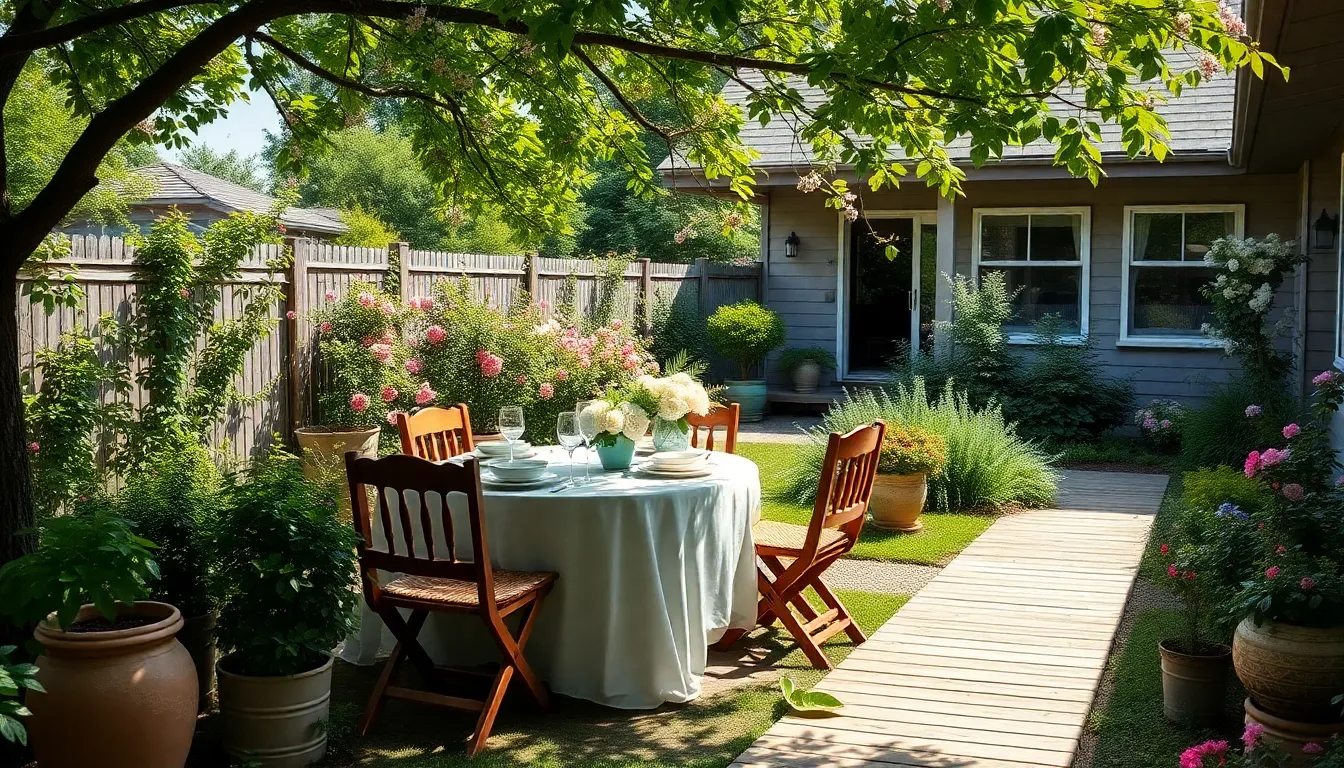
Proper placement makes all the difference in creating an outdoor dining space you’ll actually want to use. Strategic positioning transforms your garden table from simple furniture into the heart of your outdoor living experience.
Find the Ideal Shade and Sun Balance
Creating the perfect lighting environment starts with understanding how sunlight moves across your outdoor space throughout the day. We recommend observing your garden at different times to identify areas that receive morning sun but afternoon shade, as this combination provides the most comfortable dining conditions.
Natural shade sources offer the most appealing answers for garden table placement. Position your table under existing trees to take advantage of their natural canopy, which provides filtered light that’s both comfortable and atmospheric. Gazebos create defined outdoor rooms while offering adjustable shade options through curtains or retractable covers.
Artificial shade structures give you complete control over your dining environment. Install a canopy system that can be adjusted based on weather conditions and time of day. Umbrellas provide portable shade answers that can be moved as needed, while pergolas offer permanent architectural interest with the flexibility to add climbing plants for natural coverage.
Consider Views and Privacy Factors
Scenic positioning enhances every outdoor dining experience by creating natural focal points that draw the eye beyond your immediate space. We suggest placing your garden table to capture the best views of your industry, whether that’s a flower garden, water feature, or distant horizon line.
Privacy screening ensures comfortable conversation and relaxation without feeling exposed to neighboring properties or foot traffic. Strategic placement behind existing hedges, garden walls, or decorative screens creates intimate dining areas that feel secluded yet connected to the broader industry.
Visual barriers can be both functional and beautiful additions to your garden table area. Install lattice panels with climbing vines to create living privacy walls, or position tall planters filled with ornamental grasses to establish natural boundaries. Outdoor curtains attached to pergolas or gazebos offer flexible privacy options that can be adjusted for each gathering.
Plan for Easy Access to Indoor Spaces
Proximity to your kitchen streamlines outdoor entertaining by reducing the distance you need to carry food, drinks, and serving pieces. We recommend positioning your garden table within 20 to 30 feet of your indoor dining area or kitchen door to maintain a natural flow between spaces.
Level pathways eliminate tripping hazards and make it easier to transport items between indoor and outdoor areas. Create clear, well lit routes using stepping stones, gravel paths, or paved walkways that connect your garden table directly to interior spaces. Consider installing outdoor lighting along these pathways for safe evening navigation.
Service stations near your garden table reduce trips back and forth to the house during meals and gatherings. Set up a nearby potting bench or outdoor cart to hold extra dishes, napkins, and serving utensils. Weatherproof storage answers like deck boxes can hold outdoor dining essentials, keeping everything you need within easy reach of your garden table.
Maintain and Protect Your Garden Table Investment
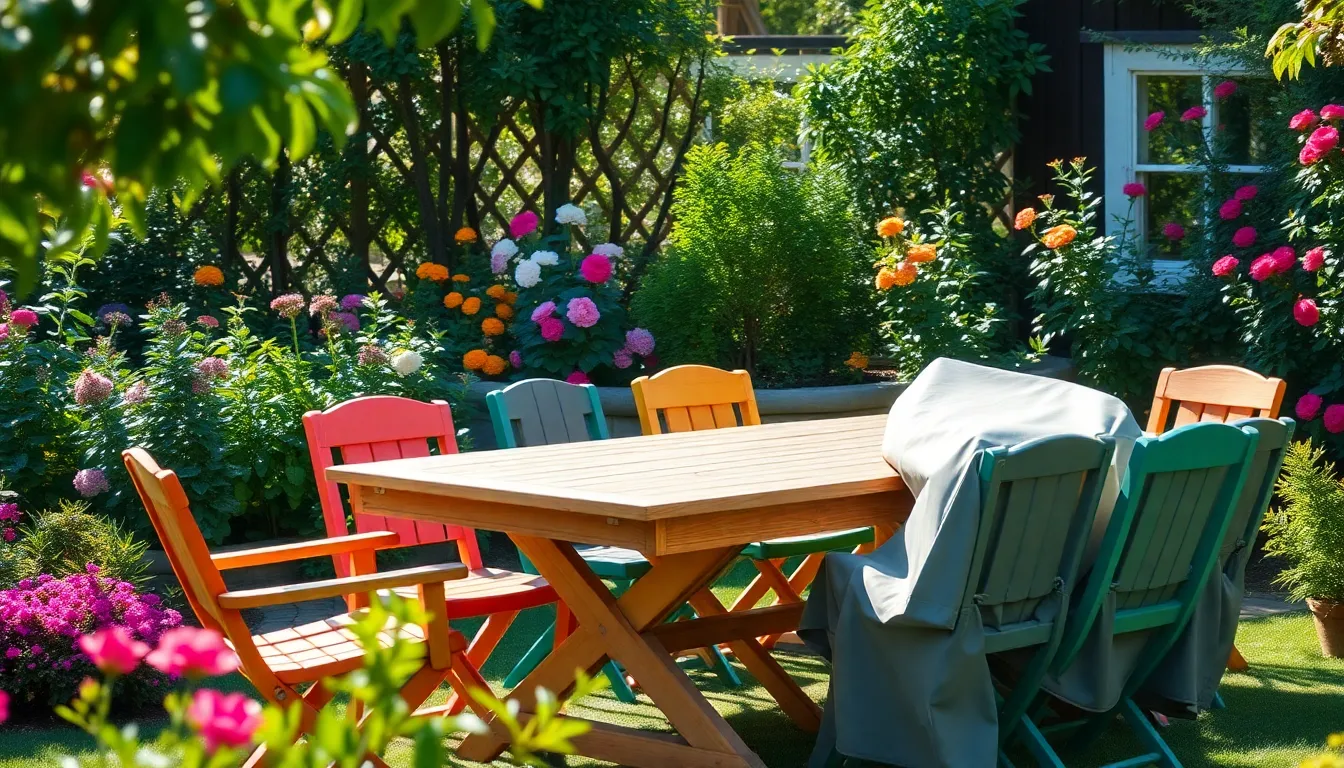
We’ve explored everything from selecting the perfect materials to styling your outdoor dining space, but none of that matters if we don’t protect our investment properly. Garden tables face constant exposure to elements that can quickly deteriorate even the highest quality materials without proper care.
Apply Proper Seasonal Treatments
Wood tables require annual protection with water-based or oil-based stains and sealants to guard against moisture and UV damage. Apply these treatments at the beginning of each season, focusing on areas where wood grain might absorb more moisture. Professional-grade sealants create a barrier that extends your table’s lifespan significantly.
Metal surfaces need gentle seasonal care using mild soapy answers to prevent rust and corrosion from forming. Focus on joints, bolts, and decorative elements where moisture tends to collect. Inspect powder-coated finishes for chips or scratches that might expose bare metal to the elements.
Stone and resin materials benefit from specialized sealants that prevent staining and weathering throughout the year. Choose products specifically formulated for your table’s material composition, as generic sealants might not provide adequate protection. Test new products on inconspicuous areas before applying them to visible surfaces.
Use Protective Covers During Harsh Weather
Weather-resistant covers made from durable materials offer the best protection against rain, snow, pollen, and bird droppings that can damage table surfaces. Select covers with reinforced seams and UV-resistant fabrics that won’t deteriorate after extended sun exposure.
Properly fitted covers prevent wind damage and ensure complete protection of your garden table investment. Measure your table’s dimensions including any umbrella holes or decorative elements before purchasing covers. Secure covers with tie-downs or elastic hems to prevent them from becoming projectiles during storms.
Storage during extreme weather extends table life beyond what covers alone can provide. Consider lightweight folding options or tables with removable components for easier winter storage. Create designated indoor storage space for cushions, umbrellas, and decorative accessories.
Perform Regular Cleaning and Inspections
Weekly dusting and wiping with a damp cloth or mild soapy solution prevents buildup that can permanently stain surfaces. Address spills immediately to prevent absorption into porous materials like wood or stone. Use microfiber cloths that won’t scratch delicate finishes.
Monthly inspections reveal early signs of wear such as chipping, cracking, or discoloration that require prompt attention. Document problem areas with photos to track deterioration over time. Address minor issues before they become major repairs that could compromise your table’s structural integrity.
High-pressure laminate surfaces need special attention during cleaning with damp microfiber cloths and mild detergent answers. Rinse thoroughly with clean water and allow surfaces to air dry completely. Avoid abrasive cleaners or scrubbing pads that can damage the protective laminate layer and expose underlying materials to moisture damage.
Conclusion
We’ve explored countless ways to transform your outdoor space with the perfect garden table. From measuring your space correctly to selecting durable materials that’ll stand the test of time these insights help you make informed decisions for your backyard oasis.
Whether you’re drawn to rustic farmhouse charm or sleek minimalist designs there’s a style that matches your vision and budget. Our DIY suggestions prove that beautiful outdoor dining doesn’t require a massive investment – just creativity and some elbow grease.
Remember that proper placement and regular maintenance are key to maximizing your garden table’s potential. With seasonal styling tips and smart features like built-in storage your outdoor dining area can evolve throughout the year while serving as the heart of your garden gatherings.
Frequently Asked Questions
What should I consider when choosing the right size garden table?
Start by measuring your outdoor space to determine maximum table dimensions. Create a visual layout considering existing furniture and landscaping. Plan for your typical guest count and ensure comfortable seating spacing. Allow adequate clearance around the table for chair movement and guest circulation, typically 3-4 feet on all sides.
Which materials are most durable for garden tables?
Teak wood offers exceptional durability with natural moisture and rot resistance, developing an attractive silvery-gray patina over time. Aluminum provides lightweight durability with rust resistance. Composite materials like resin wicker and high-density polyethylene (HDPE) lumber offer low-maintenance solutions while maintaining aesthetic appeal and weather resistance.
How can I create a rustic farmhouse garden table setting?
Focus on three key elements: weathered wood as your foundation using reclaimed or aged materials, vintage metal accents for industrial charm, and mason jar centerpieces filled with wildflowers or greenery. Layer vintage items and update seasonally to maintain visual interest and enhance the rustic theme.
What defines a modern minimalist outdoor dining design?
Use square or rectangular tables with clean lines and geometric shapes. Stick to monochromatic color schemes using gray, white, and natural wood tones. Choose sleek materials like glass and steel for durability and modern appeal, or solid wood options like teak or bamboo for warmth and organic texture.
What are some budget-friendly DIY garden table options?
Repurpose old wooden pallets with basic tools for minimal cost. Use tree stumps as natural table bases for unique aesthetics. Upcycle indoor furniture by weatherproofing and reinforcing pieces for outdoor durability. These options allow you to create beautiful garden tables without significant expense.
What modern features can maximize garden table functionality?
Look for built-in storage compartments to organize gardening tools and dining accessories. Consider integrated planters or herb gardens for fresh ingredients and visual appeal. Choose extendable surfaces for flexibility, allowing tables to adapt to varying group sizes and entertainment needs throughout the year.
How should I style my garden table for different seasons?
Spring: Use fresh flowers and greenery for vibrant displays. Summer: Focus on bold colors and Mediterranean themes. Fall: Embrace natural elements and harvest-themed centerpieces. Each seasonal approach celebrates nature’s rhythm and transforms your outdoor dining experience throughout the year.
Where should I position my garden table for maximum enjoyment?
Find the ideal balance of shade and sun by positioning under trees or using umbrellas and canopies. Consider scenic views and privacy through strategic placement and visual barriers. Locate tables within 20-30 feet of your kitchen with clear pathways for easy access and outdoor entertaining.
How do I maintain and protect my garden table?
Apply seasonal treatments like stains and sealants for wood tables, gentle cleaning for metal surfaces, and specialized sealants for stone materials. Use protective covers during harsh weather and consider proper storage options. Perform regular cleaning and inspections to prevent damage and maintain appearance.

